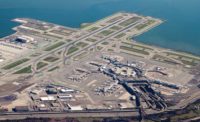Stewards of North American airports are seeing passengers return and new funding thanks to the Infrastructure Investment and Jobs Act, but staffing and sustainability pose key challenges as they plan and construct facilities for a hopefully post-pandemic traveling world.
While the new federal law provides about $5 billion annually for terminal projects, it still falls short of the $115 billion needed through 2026 for American airports, according to Airports Council International-North America, a trade association representing commercial airports in the U.S. and Canada.
"IIJA barely moves the needle on unfunded obligations," said Robert Hoxie, chief development officer for the Chicago Dept. of Aviation. At the same time, with technology and resilience needs, capital projects are "becoming systems projects" that "put upfront pressure on the planning process," he added.
Hoxie was a panelist at ACI-NA's annual conference held in Minneapolis in mid-September.
Despite the resurgent number of air passengers, "we'll be dealing with the pandemic effect for a long time," said Mike Minerva, CEO of Conrac Solutions, which provides full services for consolidated car rental facilities at airports. He noted the industry's "uneven" recovery, with not all airports and airlines getting back to 2019 traffic numbers at the same time.
"It's difficult to plan...what is your growth going to be?," he said, adding that different modes of ground transport, including emerging technologies such as autonomous and electric vehicles, make planning for the future even more complex.
Uncertainty may not go away, noted Atif Saeed, CFO of the Metropolitan Airports Commission in Minnesota, which operates Minneapolis-St. Paul International Airport, the host of the conference. "Five years from now, things will be far more unpredictable," he said. Capital construction costs are rising, yet "we must now balance maintaining costs for airline [tenants]" with fuel prices, labor costs and inflation.
Carlos Ozores, vice president and managing director at ICF, a global advisory and digital services provider, noted that more air travelers are 65 and older, and their needs must be accommodated as airports build for the future. That and other challenges such as resilience, implementation of IT infrastructure for operations and maintenance and emerging low-cost airlines all require an enterprise-level risk strategy from the top down, he said.
They also require airports, typically a "fixed-asset business," to increase flexibility in designs and operations, said Hoxie.
Concourse configurations must accommodate a mix of fleets and have dynamic signage to accommodate changes. To deliver capacity, airports need a "unified operating center for stakeholders to come together," he said. Capital projects must emphasize not only the big-ticket, "sexy" projects but also "small and not sexy but important investments" such as fixing pipes, stormwater facilities and other basic components, he said.
IIJA also provides other welcome changes for airports, including the expanded definition of eligibility for TIFIA loans—with terminals, gates, noise compatibility and conversion of service vehicles to low-emission standards now eligible for up to 15% of TIFIA budget authorization.
Environmental, social and corporate governance (ESG) is a key factor now, added Saeed. "The days of just maximizing profit for shareholders are gone," he said. "We have to be as transparent as we can be." ESG is becoming a component of bond issuances, yet "there is still confusion" about it, he noted. "What is it? How do we measure it?"
Panelists concurred that the "E" is easier to measure, but the "S" and "G" not so much. "On the capital side, we have a lot of room to do better on the S," said Hoxie. "How do we take a large project and create pockets of opportunity for [small and disadvantaged] businesses?" that lack experience in bidding and other skill sets, he said.
Justin Erbacci, CEO of Los Angeles World Airports, quoted Kermit the Frog: "It's not easy being green," and noted that standards for airports are increasing: "LEED Silver is not a big deal anymore."
He added, "We can't afford to go Platinum in all that we do, but we try to achieve the highest levels we can."
On the airline industry side, the goal is to have 10% of all aircraft using sustainable fuel by the end of the decade, said Ed Bastian, CEO of Delta Air Lines. That means 400 million gallons for Delta, he added, noting that the airline also intends to have 100% of its ground fleets electrified by 2030.
The IIJA's $5-billion allocation of terminal project funding for the first year received $14 billion in requests, Bastian said. In response, Delta is accelerating its own investments in infrastructure, exemplified by $3.5 billion for its facilities at LaGuardia International Airport in New York City.
Delta and other airlines have seen tremendous rebounds in passenger numbers, with this year's spring break period resulting in sold-out flights for large markets, he said.
"We will be back 100% by summer 2023," he said. The prediction of some in the tech industry that business travel would never come back "is hogwash," he said. "We took for granted the power of human connection."




Post a comment to this article
Report Abusive Comment